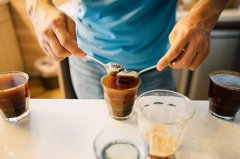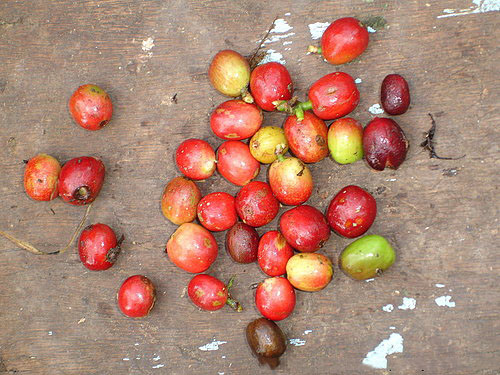Introduction of coffee cup test standard and cup test coffee sipping method

Professional coffee knowledge exchange more coffee bean information please follow the coffee workshop (Wechat official account cafe_style)
Coe Cup meter evaluation items and record key points as well as evaluation instructions
1. Essential equipment for coffee analysis:
Clean water: do not use contaminated water. Do not use distilled water and processed soft water.
Coffee spoon: stainless steel or magnetic spoon can be used instead.
Glass or magnetic cup with a capacity of 150 kb: three cups for each sample.
Coffee tray: prepare a plastic tray for each sample.
Coffee spoon: a deeper coffee spoon for sipping and stirring coffee.
Record sheet.
Coffee beans.
2. Coffee evaluation method
Coffee Cupping: Cup test, also known as coffee quality analysis.
The cup test is a method to systematically analyze the aroma and taste characteristics of coffee by using standard brewing and tasting steps. Usually with the help of the reviewer's sense of smell, taste, and oral sensation.
Prepare the sample:
Brew the coffee directly in water without using other media (such as filter paper), which will filter out the aroma or mix its flavor (like the taste of paper) into the coffee. Put the fresh coffee powder 7.25g into a magnetic cup or glass and pour 150g about 90-96 ℃ hot water directly into the cup. The coffee powder will float to the surface and will gradually sink after soaking. After about 3-5 minutes, gently stir the coffee powder floating on it, mix it well with water and sink to the bottom of the cup. Scoop out the coffee powder that has not sunk to the bottom of the cup. Note that clean water that does not contain chlorine and other chemicals must be used to avoid smelling. Remember that a cup of coffee contains 99% water.
Sensory evaluation:
In the cup test, in order to stimulate the nerves, the actions of smelling, sipping, and swallowing should be exaggerated.
The cup test consists of six steps: analyzing the aroma, aroma, taste, smell, aftertaste, and concentration of coffee.
a. Aroma Fragrance
Pour the fresh coffee powder sample into the cup, and after the fresh coffee beans are ground into powder, the carbon dioxide in the cells will release the smell and smell it hard. The aroma characteristics show the essence of taste. Sweet means sour and pungent means irritating. The aroma intensity reflects the freshness of the sample from baking and grinding to sampling.
b. Fragrance Aroma
Pour hot water into the coffee sample in the cup. The coffee powder will float on the surface and soak at rest for three minutes. Stir the coffee powder floating on it with a coffee spoon and suck in the air released by it with a deep and long nose. Can smell like fruit, grass, to stone fruit flavor. The smell is consistent with that of coffee beans. The intensity of aroma is related to the freshness of the sample.
c. Taste Taste
Use a round coffee spoon to scoop 6-8 inches of coffee liquid, close to your lips, quickly and vigorously sip the coffee liquid, so that the coffee is fully distributed on the surface of the tongue, so that the taste buds are completely stimulated by sweet, salty, sour and bitter tastes. The temperature will react to the sensation, and different sensory positions will show different characteristics. For example, temperature reduces the sweetness of sugar, making the tip of the tongue feel the tingling of sour coffee first. Hold the coffee in your mouth for 3-5 seconds, pay attention to the intensity of its taste, and find out different tastes.
d. Olfactory Nose
Step 4 is carried out at the same time as step 3. The coffee is strongly sucked into the mouth, carrying air through the tongue, and the organic matter changes from liquid to gaseous by evaporation. The strong inhalation action introduces the gas into the nasal cavity, and the sense of taste and smell act on the unique aroma of the sample at the same time. According to the standard baking degree, the smell can feel the caramelization of coffee beans (such as nutty, caramel, chocolate) according to different samples. For deep-baked samples, there are pine flavor, spice flavor, and carbon flavor.
e. Yu Yun (throat Rhyme) Aftertaste
In the imported brewed coffee, after a few seconds, the throat swallows a small part of it, making the moisture rush through the back of the upper jaw into the nasal cavity. It leaves a smell like chocolate sweetness, even campfire or tobacco. The aftertaste may be like the irritating smell of cloves or turpentine, or even a combination of these smells.
f. Concentration Body
Finally, explore the taste of the coffee liquid. The tongue slides gently across the top of the mouth. The oil in the coffee will feel greasy. Proteins show a sense of stickiness. The concentration of coffee consists of these two senses. After the coffee sample is cold, repeat three to five steps about taste, smell and aftertaste. Supplement the shadow of temperature in different ways. After the coffee is cold, make a second taste of coffee, you can get a more accurate effect. The cup test is usually used to compare two different coffee qualities. Make a cup test
Twenty-five percent of people can accurately tell the difference between the two samples. When the number of samples is large, the coffee liquid is usually spit into another cup without swallowing it. Gargle with a small amount of water, clean the taste, and then try the next sample.
The results were recorded in the Coffee Analysis record Table in detail.
.
Important Notice :
前街咖啡 FrontStreet Coffee has moved to new addredd:
FrontStreet Coffee Address: 315,Donghua East Road,GuangZhou
Tel:020 38364473
- Prev

Self-cultivation of professional cup testers-how Qualities of Cupper became a cup tester
Professional coffee knowledge exchange more coffee bean information please follow the coffee workshop (Wechat official account cafe_style) Coe cup meter evaluation items and key points as well as the evaluation shows that although every barista intuitively thinks that he should also be a cup tester, it does not take time and money to be a good cup tester, although you have worked hard to search
- Next

A coffee tree is not a tree? The cultivation method of Coffee and the Standard of fertilization in Coffee Garden
Professional coffee knowledge exchange more information about coffee beans Please follow the coffee workshop (Wechat official account cafe_style) what are the fruits and seeds of coffee? The good quality and type of coffee depends on the cultivation method of coffee the elements of coffee cultivation (the conditions of coffee cultivation) Coffee tree is called a tree, but it is actually an evergreen shrub. If
Related
- Beginners will see the "Coffee pull flower" guide!
- What is the difference between ice blog purified milk and ordinary milk coffee?
- Why is the Philippines the largest producer of crops in Liberia?
- For coffee extraction, should the fine powder be retained?
- How does extracted espresso fill pressed powder? How much strength does it take to press the powder?
- How to make jasmine cold extract coffee? Is the jasmine + latte good?
- Will this little toy really make the coffee taste better? How does Lily Drip affect coffee extraction?
- Will the action of slapping the filter cup also affect coffee extraction?
- What's the difference between powder-to-water ratio and powder-to-liquid ratio?
- What is the Ethiopian local species? What does it have to do with Heirloom native species?

